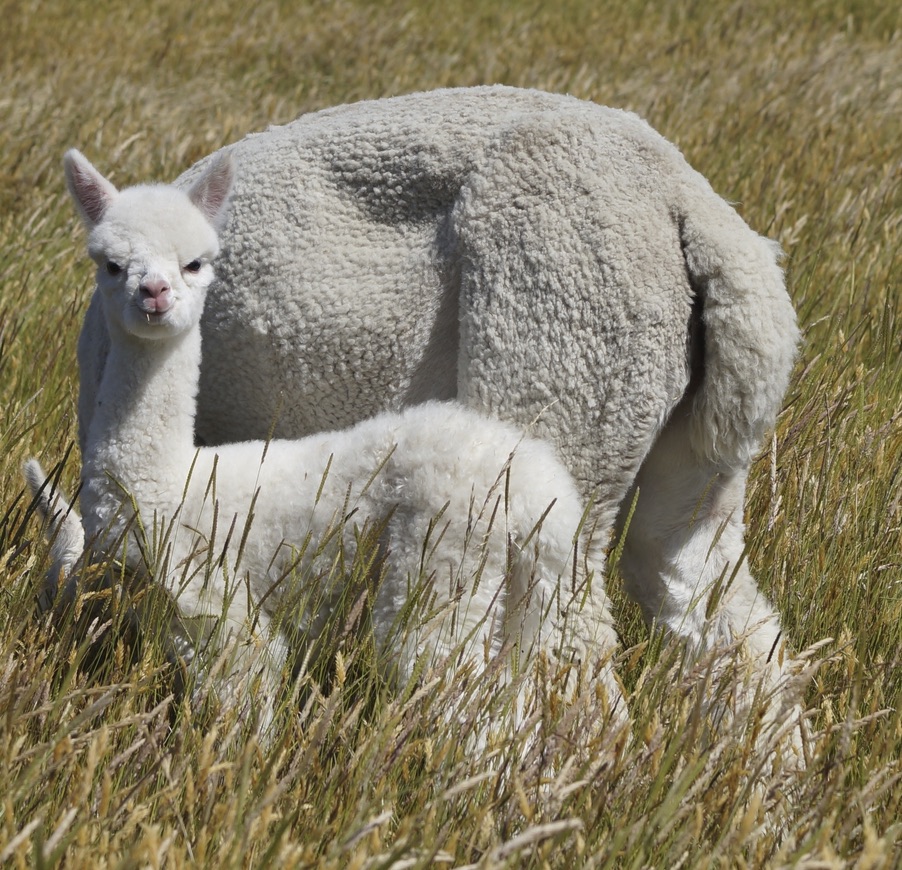Cria progress
Monitor the progress of the cria. Weigh regularly – daily initially. Plot a chart of weights of all your cria, to notice any different growth patterns. The weight of the cria may drop by 10% in the first couple of days, but once the mother’s milk supply is in, progress should be 1 to 1.5 kg a week. Observe the feeding behaviour – how often, and if satisfactory. Cria are snackers, feeding often.
General observation – look for anything different. Cria are active, and move and play a lot. A sluggish cria, resting more, and drinking less, not gaining weight, is of concern.
As a rule of thumb, a healthy cria will not allow itself to be caught easily in the paddock after the first day and when caught will make a strong attempt to escape. If your cria is caught easily or remains kushed when you walk up to it, take its temperature, and observe it closely. If its temperature is abnormally high call your vet. Cria should be 36.8 to 39.2 C.
The cria should be using its bowel by day 2. It will expel a browny-yellow meconium before that time. You rarely see a cria toilet, but in the first week you may see it straining at the dung heap. Constipation can be helped by giving a little liquid paraffin (or cooking oil), syringed under the cria’s tongue.
A cria coat is useful for a small cria in wet and/or cold conditions outside. When using a cria coat, make sure it does not cover the tail area, where the scent glands are. Mum needs to be able to smell her cria there to recognise it. She will reach round and sniff there when it is feeding.
Weaning Cria
Cria are usually weaned around the age of 6 months depending on the size of the cria and the dam. It can be a hard thing to do but is necessary to allow the female a chance to prepare for the next cria.
Some cria may need weaning as early as 4 months if they are a large size and taking all the goodness out of the dam. If you are in doubt as to whether your cria should be weaned early or if you have concerns about the condition of the dam, check with another experienced breeder or your vet for their advice.
When separating the dam and cria, put at least 2 paddocks between them and make sure the fence is intact. It is even better to keep them out of sight of each other. In their desperation cria sometimes try to find their way back and may end up in trouble eg caught in a fence or out on a roadway. Sometimes it is easier to take the dam away and leave the cria amongst familiar alpaca and surroundings.
Keep them separated for at least 2 months. It is not uncommon for cria to go back nursing after a separation of 6 weeks or longer when the dam permits it. If you return the cria to the same paddock as the dam, ensure you observe them for a week to catch any nursing.
Post Partum Females & Remating
Remating after a normal, uncomplicated birth is usually at day 14 post- partum.
Still Born or Death of a Cria
Like any other animal, alpacas need to understand their offspring is dead and also need time for mourning. Removing a stillborn directly after birth is probably the worst you can do, especially when the dam has had a cria before. They need time to come to terms with the situation and walk away themselves from the dead cria. In this situation, place the dead cria in the shade and leave the dam with it for some hours. Neonatal clinics use the stillborn and cria that die within a week of birth. If you can, please keep the cria in the freezer. Put it in a kush position or roll it up like a foetus and place it in a plastic bag and freeze it as soon as possible. The cria may help many others survive, by training breeders who need to assist with a dystocia.


